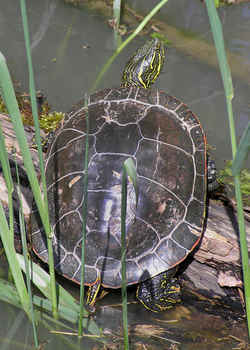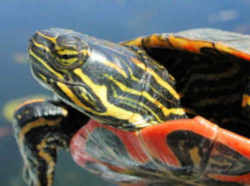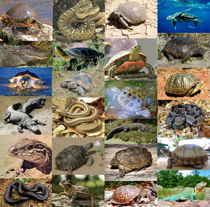Colorado State Reptile
Western Painted Turtle

(Chrysemys Picta Bellii )
Adopted on March 18, 2008
One of the newest state symbol, the Colorado State Reptile, is the western painted turtle, adopted on March 18, 2008. The painted turtle is the state reptile. How did the painted turtle get this honor? Fourth grade students asked the legislature to make the turtle the state reptile. The students said that the painted turtle is found everywhere in the state. It is also colorful- just like Colorado. The painted turtle has a dark olive shell with red markings on the edges. Its underside is yellow with bright red patterns. There are yellow or red lines on the painted turtle's head and legs.
In 2007, Jay Baichi's 4th grade class began the process to get the Western Painted Turtle designated as the Colorado State Reptile. His 4th grade class the next year completed the legal steps and Governor Ritter signed HB 08-1017 on March 18, 2008. The two classes researched Colorado reptiles and decided that the Western Painted Turtle was most representative of Colorado reptiles. The turtle (Chrysemys Picta Bellii) is a common sight around many Colorado ponds and lakes.
Colorado State Reptile: Western Painted Turtle

The painted turtle was named Colorado's official state reptile by the General Assembly in 2008. Ranging in size from 2" to just under 10", this hard-shelled turtle gets its name from bright red and/or orange markings on the underbelly. It is also identifiable by the bright yellow lines on the neck, head and limbs. Females have shells that are typically larger (up to 9.8") than males of the species. Painted turtles enter a period of hibernation during the winter months, emerging as early as February in the southern portion of its range and as late as May in the north.
Behavior
Painted turtles bask in large groups on logs, fallen trees, and other objects. The sunning helps rid them of parasitic leeches. In many areas turtles hibernate during the winter months by burrowing into the mud and allowing their bodies to become very cold. Because of their small body size, they can move easily. Turtles dive quickly at the first hint of danger. Painted turtles are diurnal; that means they are active during the day. At night they will rest on the bottom of a pond or on a partially submerged object, such as a rock. During the day, painted turtles will bask in the sun, sometimes as many as 50 on one log, stacked on top of each other.Habitat
The painted turtle is found from southern Canada to the Gulf of Mexico. They can be found from the Atlantic Coast to the Pacific Northwest and can survive at elevations from sea level to 8,500 ft. In Colorado, the painted turtle is common throughout the eastern part of the state. Smaller dispersed populations have been confirmed in southwestern Colorado's La Plata and Archuleta counties and some sightings have been reported in Moffat, Garfield and Mesa counties.Reproduction
Mating begins after hibernation and before feeding begins when the water temperatures are still low. Fall mating may also occur. Temperature is a major environmental cue for the regulation of the seasonal gonadal cycle, but the thermal dependence of the reproductive system differs markedly for the two sexes.
Colorado Law
The law designating the western painted turtle as the official Colorado state reptile is found in the Colorado Revised Statutes Title 24, Part 9, Sections 24-80-911.3 reflecting changes current through all laws passed at the First Regular Session of the Seventieth General Assembly of the State of Colorado (2015)
TITLE 24. GOVERNMENT - STATE
STATE HISTORY, ARCHIVES, AND EMBLEMS
ARTICLE 80.STATE HISTORY, ARCHIVES, AND EMBLEMS
PART 9. STATE EMBLEMS AND SYMBOLS
C.R.S. 24-80-911.3 (2015)
24-80-911.3. State reptile
The western painted turtle (chrysemys picta bellii) is hereby made and declared to be the state reptile of the state of Colorado.
Taxonomic Hierarchy: Western Painted Turtle
Kingdom: Animalia
Phylum: Chordata
Subphylum: Vertebrata
Class: Reptilia
Order: Testudines
Family: Emydidae
Subfamily: Deirochelyinae
Genus: Chrysemys - Gray, 1844
Species: C. picta
Subspecies: C. p. bellii








